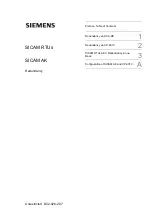
Redundancy via SCA-RS
14
Unrestricted
SICAM RTUs, SICAM AK Redundancy
Edition 10.2016, DC2-026-2.07
1.1
Overview
1.1.1
Redundancy
With redundancy one part of the system is used for the operation (active), while the other
system part is on standby.
For simple redundancy applications the processing elements are designed redundant,
whereby one is active and the other is passive (Standby). With a failure of the active
processing element a switchover to the standby can take place without any operational
interruption, refer also to section
(this way redundant automation tasks
can be realized simply and inexpensively).
With redundant communication routes, both communication interfaces can be used at the
same time for the purpose of load sharing. If one communication link fails, all data are sent
over the communication link still available. In this case one speaks of functional redundancy.
Here, this concerns communication redundancy between two identical single point protocol
elements (PRE). These must sit on the same protocol module (in other words PRE0 with
PRE1 or PRE2 with PRE3). The data are sent and received over one or the other protocol
element. In the error free state the distribution can take place either fixed (data split mode) or
according to load (load share mode)
For redundant Front-Ends the switchover can take place separately for each communication
interface. This increases the availability, especially with redundant communication routes to
the RTU.
If automation units (AU) are designed redundant, a permanent comparison of the open/closed
loop user programs can also be carried out with the help of a vendor module in the CAEx
plus
application (application-related redundancy)
Based on the system information received, a voter decides which system part is active, when
this is deactivated (switched passive) and when it activates the passive system part. The voter
therefore performs the switchover from one system part to the other, refer to section
For SICAM AK there are mainly two distinct types of redundancy:
•
CPU Redundancy
Always means the presence of one or multiple CPU pairs (including SSE and PE) within
one AU
•
AU Redundancy
Always means the presence of one AU pair with the same functionality.
This type of redundancy refers to two AUs.
In the case of CPU redundancy, up to 5 redundant processing elements can be configured in
one SICAM AK. Since the power supply can also be designed redundant, an availability is
achieved close to that with two separate automation units.















































